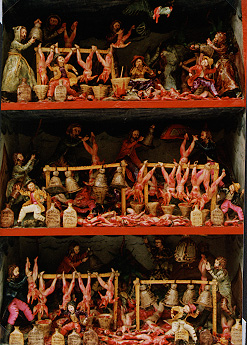Last month’s post on el Sombrerón reminded a couple of my friends of a monster their old high school Spanish teacher told them about. They’d forgotten what the creature was called, but remembered its legacy well enough for it to still disturb them some ten years later. A quick Google search yielded a goldmine of stories about this monster: the Pishtaco, a 400-year-old Peruvian terror who actually resurfaced in the news back in 2009. In him, we have a magnificent example of how monsters can dramatize the very real nightmares of a community.
Let’s roll back to the legend’s birth. In 1571 Spanish priest Cristóbal de Molina noted a specific revulsion among the Inca: they absolutely refused to bring firewood into the homes the conquistadors; not out of spite, but out of fear. It seemed that word had gotten around that during a battle some fifty years earlier, the Spanish, lacking proper dressing for their wounds, had taken Incan corpses, cut strips of flesh from their backs, and used the some human fat instead.
Now, the Inca knew that their people’s grease must be valuable–certainly it was of a better quality than that of the foreigners, as the Inca grew up with a hardier, healthier lifestyle. Fat was important in their culture; they had a whole deity devoted to it. The Spanish were already exploiting them in almost every other way–why not use that quality fat, as well? The Inca were sure that Spanish were willing to kill them for it to use in their cryptic European medicines.

A small yet horrifying depiction of Pishtacos in action, courtesy of Wikimedia Commons.
Ridiculous? Perhaps not. Funny thing: Europeans really did use human ingredients in their quests for self-improvement, and often. Sure, they often got said ingredients from condemned criminals, but did they treat the indigenous Americans any better? Fat especially was considered a remedy for arthritis and gout, and could be used to speed the healing process. Regardless of whether the Spaniards intended to take it from the Inca or not, Incan fears were not entirely unfounded. Thus the soul of the Pishtaco was born.
This fat-sucking devil appears rather human, and rather European–often he’s even described as having blonde hair. Typically handsome and sporting an impressive beard, the Pishtaco changes his clothing to stay more or less modern with the times. He carries a knife; his eyes flash in the dark. There are stories of him raising a hand to his intended victim, only for the victim to realize that the Pishtaco’s fingers are writhing like worms. As the fingers drop to the the ground, the victim then freezes with terror, giving the creature his opening to attack. This is one of many examples that illustrate how adept the creature is at hypnosis; he doesn’t seem to need more than a command or a look to secure his victim’s fate.
The Pishtaco has been categorized by some as a vampire, albeit an odd one. Though it’s true that in some versions of the legends he eats what fat he extracts, more often he seeks to profit from it, usually by selling it to other foreigners. This role is one of the most fascinating aspects about the creature: he’s an outsider, an invasive species. What exactly the Europeans have been suspected to do with the fat he sells them has changed over the years…first it was incorporated into medicine, then friars were suspected of using it to oil their church bells to make them more sonorous, now it could be used in plane engines or beauty products.

Human fat, courtesy of Bullenwachter over at Wikimedia Commons. You’re welcome.
So how does he extract the fat from his victims? In the more supernatural versions of the tale, the Pishtaco sucks the fat out through his victim’s skin or inserts a tube to tap them like a woodsman taps sap from a tree. Said to be priapic and rather violent, he occasionally rapes them while he’s at it. Sometimes the victim even survives the procedure, finding a strange gaps in their memory and feeling suddenly lightheaded and weak. In the more literal (and recent) accounts, the Pishtaco is less forgiving. He dismembers the victim entirely, then strings their body parts up to hand over an open flame, bottles lined under to collect their dripping fat.
It was a few of these grease-filled bottles that caused such a stir in 2009. The Peruvian police reported that they’d apprehended a group of men who had been trafficking human lard since the 1980’s. There was video footage of the trafficker’s lab, complete with stacks of bones and a half-rotted man’s head. One of the men confessed to selling the bottles of fat–which tested positive as human–to the Italian Mafiosi for $15,000 a pop. The police said that this grease was to be used in European skin softener. The legendary Pishtaco had suddenly come terribly to life.
Fortunately, this particular incident turned out to be a hoax: there wasn’t really any fat sold to the Europeans (or at least, no one could find anyone who might have been buying it), and the numbers and locations of alleged victims and perpetrators didn’t add up. Unfortunately, the police were the ones perpetrating the hoax, and had done so to cover up a secret governmental death squad that killed 46 people over the span of two years. This was a horror of its own, and did little to quell Peruvians’ fears. People continued (and still continue) to see Pishtacos everywhere. They are the businessman with his briefcase; the fellow with headphones giving you the side-eye. Some say the Pishtacos are planning an onslaught; some even claim they plan to harvest hundreds of Peruvians to pay off the national debt.
Though there hasn’t been any big news since the police scare, I doubt that the Pishtaco’s story is over. Even if human fat trafficking is a stretch, organ trafficking isn’t. What’s more, the perpetrators in 2009 never themselves claimed to be selling things to cosmetic companies–they were more in the line of Satanic candles, which is a little easier to imagine, so there might have be some truth in that tale. Between all this and the terrible historical context of the Andes, it’s no wonder people are jumpy.
Sometimes, the things that go bump in the night come uncomfortably close to reality.
Have you seen (or heard) any Pishtaco-type tales? Did you pronounce the word “fish taco” or “pistachio” in your head, and then giggle uncontrollably? Share your story in the comments below.
Featured image by Sebastian Pociecha.





0 Comments